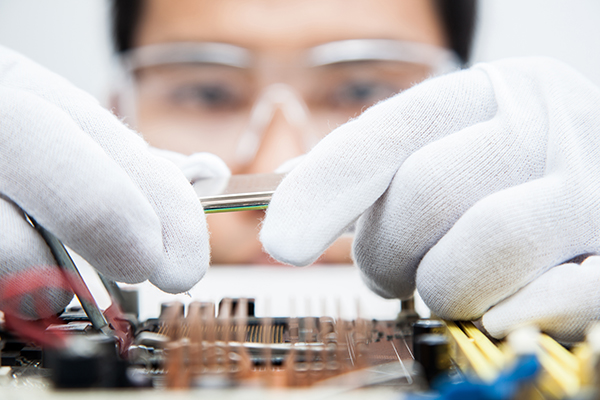Key Concepts
The branch of engineering that deals with electric and magnetic forces and their effects. Electrical engineers have a wide scope of work, which includes designing computers and incorporating them into devices and systems (see Illustration). Electrical engineers design two-way communications systems such as telephones and fiber-optic systems, and one-way communications systems such as radio and television, including satellite systems. Electrical engineers design control systems, such as aircraft collision-avoidance systems, and a variety of systems used in medical electronics. Electrical engineers are involved with generation, control, and delivery of electricity to homes, offices, and industry. Electrical engineers analyze and interpret computer-aided tomography data (CAT scans) for materials, seismic data from earthquakes and well drilling, and data from space probes, voice synthesizers, and handwriting recognition. They design systems that educate and entertain, such as computers and computer networks, and multimedia systems. See also: Character recognition; Communications satellite; Computer; Computerized tomography; Control systems; Digital computer; Electric heating; Electric power generation; Electric power systems; Electric power transmission; Electrical communications; Electricity; Engineering; Illumination; Magnetism; Multimedia technology; Optical communications; Optical fibers; Radio; Telephone service; Television; Voice response

Early development
Early experimenters developed key components, including batteries, electromagnets, and electric motors, widely used in electrical engineering applications. For instance, in 1832, English physicist and chemist Michael Faraday showed that electric and magnetic effects are not separate. He combined the results of various observations into a single theory of electromagnetic induction. The first major commercial application of electromagnetism was the telegraph, demonstrated in 1844. See also: Battery; Electromagnet; Electromagnetic induction; Motor; Telegraphy
The last quarter of the nineteenth century saw rapid developments in lighting, stemming from the invention of the incandescent lamp, and in electric power generation and delivery. During this period, lighting moved to homes, offices, and schools, and motors powered new forms of transportation and began to transform factories. A major technical debate in this period was whether to generate and distribute electric energy as direct current or alternating current. After the invention of the transformer in 1883, alternating-current generation and delivery quickly became the dominant system, because of its greater efficiency and versatility. See also: Alternating current; Direct current; Electric rotating machinery; Incandescent lamp; Transformer
The latter nineteenth and early twentieth centuries saw the development of the telephone and wireless telegraphy. Telegraph wires provided communications for railroads and nearly instantaneous message capability for business, industry, and personal data, while the telephone industry grew rapidly. Wireless telegraphy linked continents with high-powered spark transmitters.
Electronics
The audion, invented in 1906 and later called the triode, was a vacuum tube (or valve) with three electrical elements. The triode was used to design and build amplifiers, a basic element in modern electronics. Amplifiers enable a weak information signal to control a local power source, yielding a more powerful output. Amplification and other applications of tubes enabled the rapid development of the electronics industry. The junction transistor, whose invention in 1948 followed that of the point-contact transistor in the previous year, became the dominant electronic device by the 1960s, replacing vacuum tubes. See also: Amplifier; Transistor; Vacuum tube
The integrated circuit, invented in 1959, quickly revolutionized electronics. This device or process enables designers to put many transistors and associated components into a single package. These units made the personal computer a reality, and have become nearly ubiquitous, existing in home appliances, cars, offices, and factories. See also: Electronics; Embedded systems; Integrated circuits; Microcomputer; Microprocessor
Feedback
Electronic devices can produce, along with amplification, distorted output signals. An invention of the 1920s, called negative feedback, reduces this problem. A fraction of the amplifier output signal is subtracted from the input signal. While this subtraction reduces gain and signal level, it also reduces distortion. The idea illustrates the trade-offs that must be made throughout the design process, as competing requirements are balanced. While positive feedback can sometimes find application, it is often a serious problem in electronics. Positive feedback is responsible for the screeching sound in a public address system when a person inadvertently points a microphone at a loudspeaker. See also: Distortion (electronic circuits); Feedback circuit
Control systems
Control systems use feedback. Common examples are thermostats that control furnaces or air conditioners. Automobile cruise controls and automatic pilots for aircraft are applications. Other examples are found in chemical processes and steel-rolling mills. In control systems, electronic circuits enable desired results to be compared with actual results, and the feedback enables the reduction of the error to nearly zero. Electrical engineers work with other engineers in the design and development of control systems. See also: Autopilot; Control systems; Process control; Thermostat
Computers
Electrical engineers have had a major role in the continuing development and application of computers. They have worked with computer engineers, computer scientists, and other professionals in designing the first as well as new, innovative types of data-storage systems, central processing units (CPUs), displays, and the networks connecting computers, including the Internet. See also: Computer storage technology; Data communications; Electronic display; Internet
Optics
In optical communications, another major contribution of electrical engineering, light pulses and waves carry data over very small strands of glass. See also: Optical communications
Challenges
The integration of communications equipment, control systems, computers, and other devices and processes into reliable, easily understood, and practical systems is a major challenge, which has given rise to the discipline of systems engineering. Electrical engineering must respond to numerous demands, including those for more efficient and effective lights and motors; better communications; faster and more reliable transfer of funds, orders, and inventory information in the business world; and the need of medical professionals for access to medical data and advice from all parts of the world. See also: Information systems engineering; Medical information systems; Systems engineering





